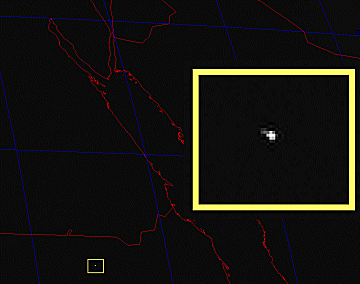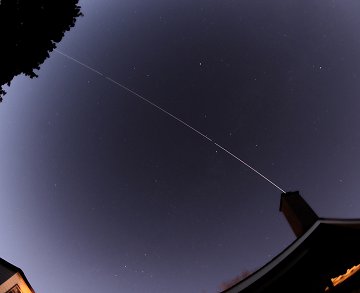| BEHOLD THE SUN: Would you like to see fiery prominences and new-cycle sunspots with your own eyes? On sale now: Personal Solar Telescopes. | | | DRACONID METEOR SHOWER: The pelting continues. One day after asteroid 2008 TC3 hit Earth, a stream of dust from comet 21P/Giacobini-Zinner is doing the same. The result is a minor shower of meteors emerging from the northern constellation Draco. At maximum on Oct. 8th, the Draconids are expected to produce 3 to 5 meteors per hour. ASTEROID IMPACT: (Updated Oct. 8th) On Oct. 7th, asteroid 2008 TC3 hit Earth and exploded in the atmosphere over northern Sudan. An infrasound array in Kenya recorded the impact: map. Dr. Peter Brown of the University of Western Ontario has inspected the data and he estimates that the asteroid hit at 0243 UTC with an energy between 1.1 and 2.1 kilotons of TNT. The explosion was imaged by the weather satellite Meteosat 8: 
Image credit: Zdenek Charvat, Czech Hydrometeorological Institute
"The explosion was visible in all 12 of the satellite's spectral channels, covering wavelengths from 0.5 to 14 microns," says Jiri Borovicka
of the Czech Academy of Sciences, who is analyzing the data. "The satellite takes pictures every five minutes; the fireball appeared at 0245 UTC and had faded away by 0250 UTC." So far, no ground pictures of the fireball have been submitted; the impact occurred in a remote area with few and possibly no onlookers capable of recording the event. The only report of a visual sighting comes from Jacob Kuiper, General Aviation meteorologist at the National Weather Service in the Netherlands: "Half an hour before the predicted impact of asteroid 2008 TC3, I informed an official of Air-France-KLM at Amsterdam airport about the possibility that crews of their airliners in the vicinity of impact would have a chance to see a fireball. And it was a success! I have received confirmation that a KLM airliner, roughly 750 nautical miles southwest of the predicted atmospheric impact position, has observed a short flash just before the expected impact time 0246 UTC. Because of the distance it was not a very large phenomenon, but still a confirmation that some bright meteor has been seen in the predicted direction. Projected on an infrared satellite image from Meteosat 7, I have indicated the position of the plane (+) and the predicted impact area in Sudan (0)." 2008 TC3 was discovered on Oct. 6th by astronomers using the Mt. Lemmon telescope in Arizona as part of the NASA-funded Catalina Sky Survey for near-Earth objects. Asteroids the size of 2008 TC3 hit Earth 5 to 10 times a year, but this is the first time one has been discovered before it hit. BONUS: 2008 TC3 was so close to Earth, different observers around the globe saw the asteroid trace different paths among the stars. This effect, called parallax, is beautifully illustrated in a compilation of 566 published observations prepared by Matthias Busch: image. SPACE STATION SIGHTINGS: The International Space Station (ISS) is flying over North America this week. "Here it is appearing to enter my chimney in Peterborough, Ontario," says Phillip Chee who recorded the flyby using his Nikon D200 and a fisheye lens: 
"The space station was easy to see in twilight," says Chee. "I estimate its magnitude at -2.4." Because it's so big and bright, the station looks great through a backyard telescope. Last night, Ari Koutsouradis of Westminster, Maryland, took this picture through his 8-inch Celestron: 
"Using Spaceweather's satellite tracker, I was able to set up my telescope and easily locate the ISS as it flew overhead," says Koutsouradis. "The camera, a Nikon D50, was set to ISO1600 with a shutter speed at 1/400 s." Readers, see for yourself! Click here for viewing times. more images: from Wienie Van der Oord in the Arava desert of Israel; from Daniel O'Malley of DeWitt, Michigan; from Craig W. Weiss of Palo Alto, California; from Curtis Warrenfeltz of Virginia Beach, Virginia;
Oct. 2008 Aurora Gallery
[Previous Octobers: 2007, 2006, 2004, 2003, 2002, 2001, 2000] | 
